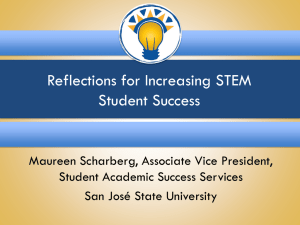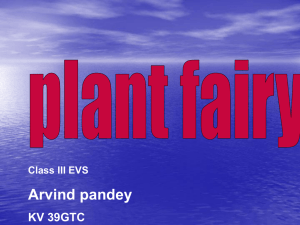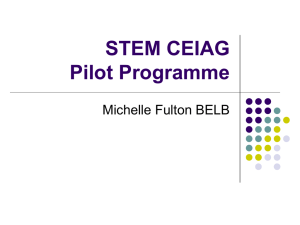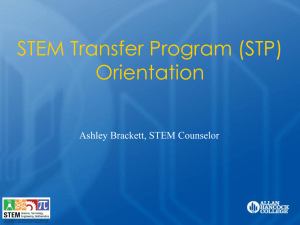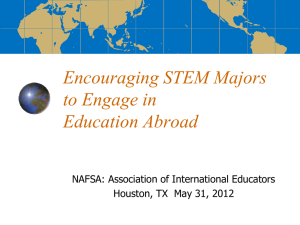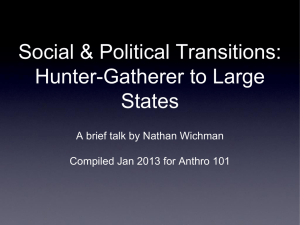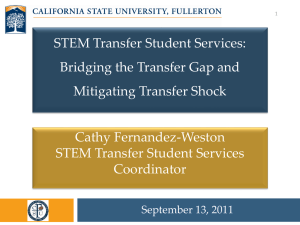Transfer Student Capital
advertisement
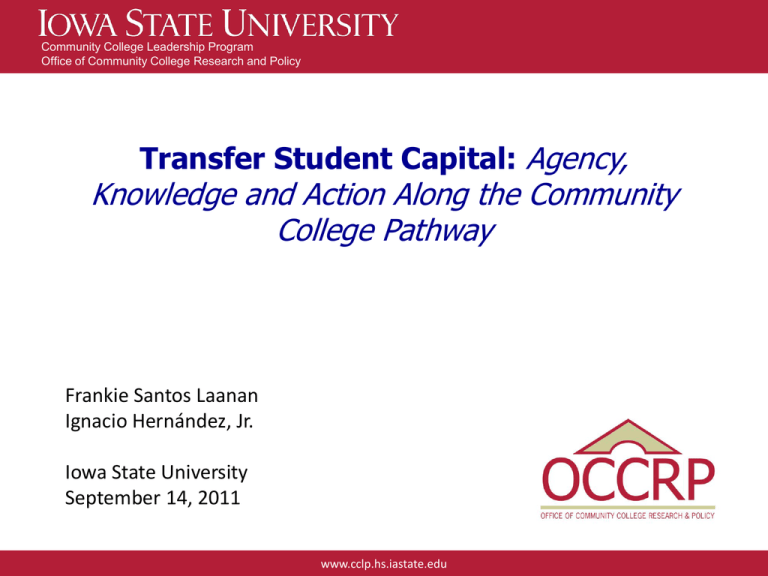
Community College Leadership Program Office of Community College Research and Policy Transfer Student Capital: Agency, Knowledge and Action Along the Community College Pathway Frankie Santos Laanan Ignacio Hernández, Jr. Iowa State University September 14, 2011 www.cclp.hs.iastate.edu • CCLP Homepage www.cclp.hs.iastate.edu About OCCRP • The Office of Community College Research and Policy (OCCRP) at Iowa State University is focused on creating, sharing, and applying knowledge in the context of community college education. • The mission of the OCCRP is to articulate and analyze the issues affecting policy and practice by conducting rigorous research which impacts students, faculty, administrators, and policymakers. • The OCCRP is committed to sharing our research with diverse constituents through dissemination efforts such as publications, conference presentations, and professional workshops www.cclp.hs.iastate.edu The Role of Community Colleges • Open access to postsecondary education • Prepare students to transfer to 4-year institutions • Providing workforce development and skills training • Offering a wide variety of noncredit programs Source: American Association of Community Colleges. (2011). Community college trends and statistics. Retrieved from http://aacc.nche.edu/AboutCC/Trends/Pages/default.aspx www.cclp.hs.iastate.edu The Role of Community Colleges Reasons for attendance: – Complete credits toward a bachelor’s degree – Gain further skills or knowledge in an academic or occupational field – For leisure or personal interest – To prepare for college or increase chances of being accepted – For financial reasons – To complete an associate’s degree Source: Tsapogas, John. (2004). The role of community colleges in the education of recent science and engineering graduates. National Science Foundation InfoBrief, NSF 04-315. www.cclp.hs.iastate.edu Figure 1. Conceptual Framework of Educational Trajectories via Community College G.E.D. Developmental Education High School Employment Certificate Community College Dual Credit Joint Enrollment Four-Year University Family Literacy A.A. Degree Transfer A.S. Degree A.A.S. Degree Source: Laanan, 2009 www.cclp.hs.iastate.edu Employment Community College Students as a Percentage of U.S. Undergraduates • All U.S. undergraduates: 44% • First-generation college students: 39% • First-time freshman: 40% • Native American: 52% • Asian/Pacific Islander: 45% • Black: 43% • Latina/o: 52% Source: American Association of Community Colleges (2010) www.cclp.hs.iastate.edu 36% of Community College Students are Students of Color www.cclp.hs.iastate.edu Background and Problem • The purpose of this study was to examine the role of Transfer Student Capital in the academic adjustment of transfer students in STEM majors at Iowa State University • The community college transfer function is a crucial mediator for students seeking a baccalaureate degree (Laanan, 2007) • Iowa State University enrolls more Iowa community college transfer students than any other four-year institution in the state (Laanan & Ebbers, 2006) www.cclp.hs.iastate.edu Community College Transfer Students • Movement from community colleges to baccalaureate-granting institutions continues to grow steadily (Planty, Hussar, & Snyder, 2009) • Community college transfer students are complex, transfer process is multidimensional (Laanan, Starobin, & Eggleston, 2010) • Diversifying human capital while bridging the socioeconomic gap at baccalaureate-granting institutions (Dowd, Cheslock, & Melguizo, 2008) www.cclp.hs.iastate.edu Community College Transfer Students • Demographic and population shifts during the next 10 years will likely alter the profile of the typical community college transfer student (Lester, 2006) • In 2007, 6.6 million of the 15.6 million students enrolled in US undergraduate programs attended community colleges (Reyes, 2011) • Transfer students describe community college classrooms as “breeding grounds” for interest in the sciences and university lecture halls as “weeding grounds” to relieve impacted majors (Chang, 2006) www.cclp.hs.iastate.edu Community Colleges and STEM • STEM fields have become drivers of economic growth and competitiveness. From 1950 to 2000, the number of individuals in science and engineering occupations grew about 2300% (National Science Board, 2008) • Community colleges serve a vital role in stimulating the numbers of STEM degree recipients and skilled workers completing associate degrees (Hoffman, Starobin, Laanan, & Rivera, 2010) • NSF initiatives such as STEM Talent Expansion Programs (STEP) and Advanced Technological Education (ATE) seek to increase STEM transfer rates (National Science Foundation, 2001) www.cclp.hs.iastate.edu Challenges to Pursuing a STEM Degree • Chilly climate for women and minorities in classroom (Hurtado et al., 2007) • Lack of academic preparation (Perna et al., 2009) • Absence of role models (Seymour and Hewitt, 1997) • Gender stereotypes (Seymour, 1995; Low et al., 2005) • Self-confidence (Pajares, 2005) • Financial concerns (Oseguera et al., 2006) www.cclp.hs.iastate.edu Review of the Literature • Academic Adjustment & Transfer Socialization – Difficulty in adjusting to the 4-year environment is likely related to difficulties in adjusting to the academic standards (Laanan, 2007, Napoli & Wortman, 1998) – Major responsibilities for facilitating academic and social integration of transfer students will likely fall to student affairs staff (Townsend & Wilson, 2006) – University faculty should be aware that efforts to socialize first-year students may work against the integration of transfer students (Townsend & Wilson, 2006) www.cclp.hs.iastate.edu Theoretical Frameworks Forms of Capital • Cultural Capital (Bordieu, 1986) • Social Capital (Bordieu, 1986) • Community Cultural Wealth (Yosso, 2005) – – – – – – Aspirational Capital Familial Capital Navigational Capital Social Capital Resistant Capital Linguistic Capital www.cclp.hs.iastate.edu Theoretical Frameworks • Sojourner Adjustment – Students moving between institutions must access multiple information sources and make sense of it. Adjustment depends on the efficacy of the interpersonal relationships in the newly acquired host environment (Brein & David, 1971) • Transfer Student Capital – Coined by Laanan (2006). Cumulative knowledge and experiences of higher education environments promote successful adjustment for students transferring from a community college to a 4-year university (Laanan, Starobin, & Eggleston, 2010) www.cclp.hs.iastate.edu Conceptual Model Background Characteristics Community College Experiences • Transfer GPA • Transfer Credits • Associate Degree • Gender • Mother’s Education • Degree aspiration • STEM Status Transfer Student Capital (TSC) • Learning and Study Skills • Advising/Counseli ng • Transfer Process • Experience with Faculty • Course Learning www.cclp.hs.iastate.edu University Experiences • University GPA • Faculty interaction • Social adjustment • Transfer stigma • Psychological adjustment • Financial mediators • Advising/Couns eling Outcome Academic Adjustment DV • Difficulty adjusting to academic standards • Dip in grades (GPA) • Increased stress levels Research Questions 1. What are the background characteristics and demographics of STEM and non-STEM community college transfer students at a four-year, public, research-intensive university? 2. What background characteristics, community college, and university factors predict academic adjustment among transfer students? 3. Controlling for STEM status, what background characteristics, community college, and university factors predict academic adjustment? 4. To what extent does “transfer student capital” (TSC) influence academic adjustment for all transfer students and STEM transfer students, specifically? www.cclp.hs.iastate.edu Methodology • Survey research design – Target population: Community college transfer students at Iowa State University. – Sampling frame: Students who transferred between fall 2006 and spring 2009 • Instrumentation – Laanan-TSQ© (1998, 2007, 2010) • Three main sections: Social demographics, Community College experiences, University experiences • Measures non-cognitive or affective traits • Likert-type scales: levels of agreement, frequency – Qualtrics™online survey software www.cclp.hs.iastate.edu Methodology • Data analysis – Descriptive statistics: frequencies and crosstabulations, odds ratios – Hierarchical Linear Regression • Exploratory Factor analysis – Data reduction – Varimax rotation for clearer separation of factors (Kim & Mueller, 1978) www.cclp.hs.iastate.edu Variables Exploratory Factor Analysis Constructs Number of Items α Advising and Counseling 6 0.93 Faculty Interaction 6 0.91 Learning Skills 5 0.88 Coursework Experiences 6 0.86 Transfer Process 6 0.84 Advising and Counseling 2 0.76 Faculty Interaction 6 0.91 Transfer Stigma* 3 0.87 Financial Mediators 3 0.79 Social Adjustment 4 0.76 Psychological Adjustment 3 0.72 3 0.65 Transfer Student Capital University Dependent Variable Academic Adjustment www.cclp.hs.iastate.edu Research Question #1 Total Sample: N=858 • Non-STEM Majors (n=467) – Humanities – Social Sciences – Design • STEM Majors (n=391) – Agricultural Sciences – Engineering – Physical and Biological Sciences www.cclp.hs.iastate.edu Research Question #1 Distribution Within STEM Majors Biological Sciences 22% non STEM n= 467 STEM n= 391 Agricultural Sciences 35% Engineering 40% Mathematical Sciences 2% Physical Sciences 2% www.cclp.hs.iastate.edu Research Question #1 Ethnic Distribution Within STEM Majors Native American 1% White 85% Non-white 15% Other/ Refuse to State 7% Latina/o 2% Black 1% www.cclp.hs.iastate.edu Asian American 4% Research Question #1 • Females are 4.05 times more likely to be majoring in a non-STEM degree than a STEM degree. • Males are 1.65 times more likely to be majoring in a STEM degree than a non-STEM degree. • STEM majors are 2.58 times more likely to be male than female. STEM Status by Gender 70.0% 60.0% 66.6% 56.4% 50.0% 43.6% 40.0% 33.4% 30.0% 20.0% 10.0% 0.0% non-STEM Female www.cclp.hs.iastate.edu STEM Male Research Question #1 Degree Aspiration 35.0% Associates Degree Completion 59.0% 32.7% 58.1% 58.0% 30.0% 25.7% 57.0% 25.0% 56.0% 20.0% 15.2% 55.0% 15.0% 12.3% 54.0% 54.0% 10.0% 53.0% 5.0% 52.0% 0.0% Master's non-STEM Doctorate 51.0% non-STEM STEM www.cclp.hs.iastate.edu STEM Associates Degree Completion NonSTEM STEM Who earns an Associates degree as they transfer? No Yes 252 215 467 227 164 391 479 379 N=858 – Non-STEM majors completed 31% more of the degrees. – Only 42% of STEM majors completed their degrees. www.cclp.hs.iastate.edu Q&A www.cclp.hs.iastate.edu Community College Leadership Program Office of Community College Research and Policy Regression Models www.cclp.hs.iastate.edu Research Question #2 Variables Block 1 STEM Status Degree Aspiration Mother’s Education Gender Block 2 Transfer GPA Transfer Credits Associate Degree Completion Block 3 Community college: Learning skills Community college: Advising/counseling Community college: Faculty interaction Community college: Coursework experiences Community college: Transfer Process Block 4 University: Faculty interaction University: Social adjustment University: Transfer stigma University: Psychological adjustment University: Financial mediators University: Advising/counseling University GPA * p < .05, ** p < .01, *** p < .001 All Transfer Students (n=858) Final beta R2=0.030 0.178*** 0.029 -0.002 -0.082* R2=0.037 R2 Change=0.007 0.180*** -0.026 0.00 R2=0.200 R2 Change=0.164 -0.086 0.107** 0.150*** -0.194*** -0.096* R2=0.407 R2 Change=0.207 Adjusted R2=0.382 -0.028 -0.167*** 0.016 0.167*** 0.032 -0.129*** -0.381*** Variables Block 1 Degree Aspiration Mother’s Education Gender Block 2 Transfer GPA Transfer Credits Associate Degree Completion Block 3 Community college: Learning skills Community college: Advising/counseling Community college: Faculty interaction Community college: Coursework experiences Community college: Transfer Process Block 4 University: Faculty interaction University: Social adjustment University: Transfer stigma University: Psychological adjustment University: Financial mediators University: Advising/counseling University GPA * p < .05, ** p < .01, *** p < .001 STEM Transfer Students (n=391) Final beta R2=0.008 0.001 -0.006 -0.080 R2=0.013 R2 Change=0.006 0.160* -0.090 -0.007 R2=0.206 R2 Change=0.192 -0.027 0.058 0.258*** -0.321*** -0.030 R2=0.425 R2 Change=0.219 Adjusted R2=0.377 -0.113 -0.241*** 0.043 0.163** 0.030 -0.147** -0.303*** Conclusions • STEM status was a statistically significant, positive predictor of academic adjustment. • Influence of Transfer Student Capital factors were statistically significant in predicting academic adjustment. • Transfer student adjustment to ISU should be considered contextually. • Institutional type, mission, geography www.cclp.hs.iastate.edu Discussion • In predicting transfer students’ academic adjustment, statistically significant background predictors include: – Being male – Having a higher transfer GPA – Selecting a non-STEM transfer major • Accessing and activating each individual’s Transfer Student Capital can be a significant contributor to a student’s adjustment experience www.cclp.hs.iastate.edu Recommendations for Increasing Student Gains STEM Fields • Peer and faculty support (Cole & Espinoza, 2008) • Begin preparation earlier for students – start in middle school (Elliott et al., 1996) • Research opportunities foster success and interest in STEM (Carlone & Johnson, 2007) • Relevance of coursework to lives increases persistence (Bonous-Hammarth, 2000) • Show a clear pathway to a baccalaureate degree (Starobin & Laanan, 2008) • Build bridges between institutions – have a clear articulation agreement for transfer (NSF, 2001) www.cclp.hs.iastate.edu Implications • University programs helping transfer students adjust should help students recognize and activate their unique forms of transfer student capital • Efforts to help transfer student transition should be major specific within the STEM fields • Faculty and student affairs staff should pay closer attention to the adjustment experiences of female, non-STEM students, especially considering transferreceiving university’s academic culture www.cclp.hs.iastate.edu Policy Recommendations • NSF should provide incentives for colleges and universities to improve transfer pathways to bachelor’s degree at HSIs in the biological, agricultural, and environmental sciences and in engineering. • Institutions should respond to the need for increased participation by Latinas and Latinos in STEM fields by examining institutional data disaggregated by race and ethnicity in order to identify curricular and structural obstacles to transfer students’ bachelor’s degree completion in STEM fields. www.cclp.hs.iastate.edu Policy Recommendations • Data on student success in and progression through key gateway and gatekeeper courses should be examined as part of NSF’s Hispanic Serving Institutions Undergraduate Initiative proposal review, funding, and evaluation processes. • Funding for faculty involvement in curricular innovation and collaboration among four-year and two-year college professors is essential for increasing high quality educational opportunities for Latinos in STEM fields. www.cclp.hs.iastate.edu Future Research • Connect TSQ survey data with student transcript level data; longitudinal design. • Impact of Associate degree completion for Iowa’s community college students. • Employ a qualitative design to further understand the personal experiences of STEM and non-STEM transfer students. • Test the influence of Transfer Student Capital with disaggregated STEM majors www.cclp.hs.iastate.edu Q&A www.cclp.hs.iastate.edu Contact Information Frankie Santos Laanan Associate Professor Community College Leadership Program Educational Leadership & Policy Studies Iowa State University Ignacio Hernández, Jr. Graduate Research Assistant Community College Leadership Program Educational Leadership & Policy Studies Iowa State University laanan@iastate.edu 515.294.7292 ignacio@iastate.edu www.cclp.hs.iastate.edu www.cclp.hs.iastate.edu Selected References Coleman, J.S. (1988). Social capital in the creation of human capital. American Journal of Sociology, 94, S95-S120. Knofczynski, G.T., & Mundfrom, D. (2007). Sample sizes when using multiple linear regression for prediction. Educational and Psychological Measurement, 68(3), 431-442 Laanan, F.S. (2003). Degree aspirations of two-year college students. Community College Journal of Research and Practice, 27, 495-518. Laanan, F.S. (2004). Studying transfer students: Part I: Instrument design and implications. Community College Journal of Research and Practice, 28, 331-351. Laanan, F.S. (2007). Studying transfer students: Part II: Dimensions of transfer students’ adjustment . Community College Journal of Research and Practice, 31, 37-59. Laanan, F.S., & Ebbers, L.H. (2008). Iowa community college transfer students: Profiles, experiences and perceptions. Ames, IA: Iowa State University, Office of Community College Research and Policy. Laanan, F.S., Starobin, S.S., & Eggleston, L.E. (2010). Adjustment of community colleges students at a four-year university: role and relevance of transfer student capital for student retention. Journal of College Student Retention, 12(2), 175-209. Napoli, A. R., & Wortman, P. M. (1998). Psychosocial factors related to retention and early departure of two-year community college students. Research in Higher Education, 39(4), 419-455. Sax, L.J., Gilmartin, S.K, Lee, J.J., & Hagedorn, L.S. (2008). Using web surveys to reach community college students: an analysis of response rates and response bias. Community College Journal of Research and Practice, 32, 712-729. Smith, B. (2007). Accessing social capital through the academic mentoring process. Equity & Excellence in Education, 40, 36-46. Townsend, B.K., & Wilson, K.B. (2006). "A hand hold for a little bit": Factors facilitating the success of community college transfer students to a large research university. Journal of College Student Development, 47(4), 439-456. www.cclp.hs.iastate.edu
